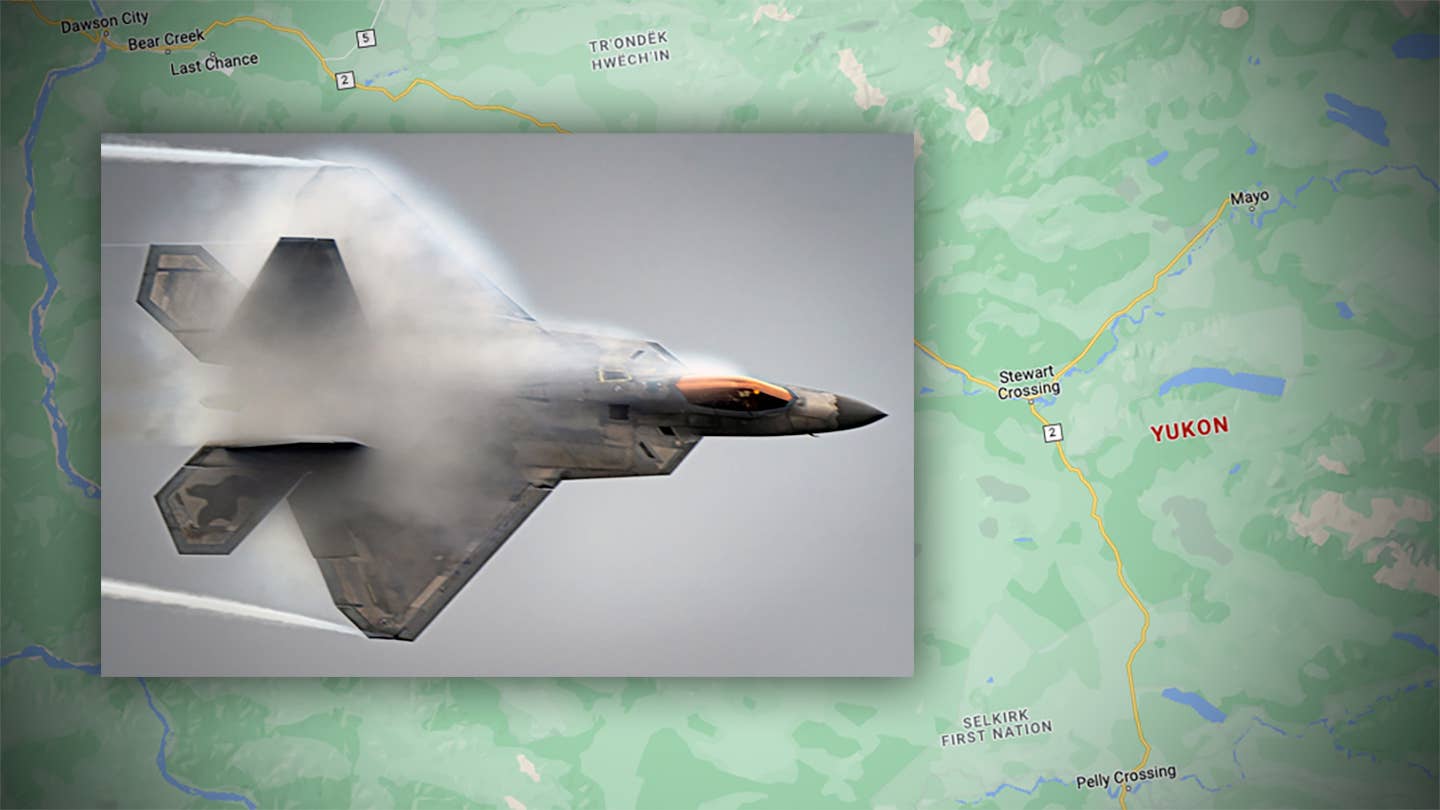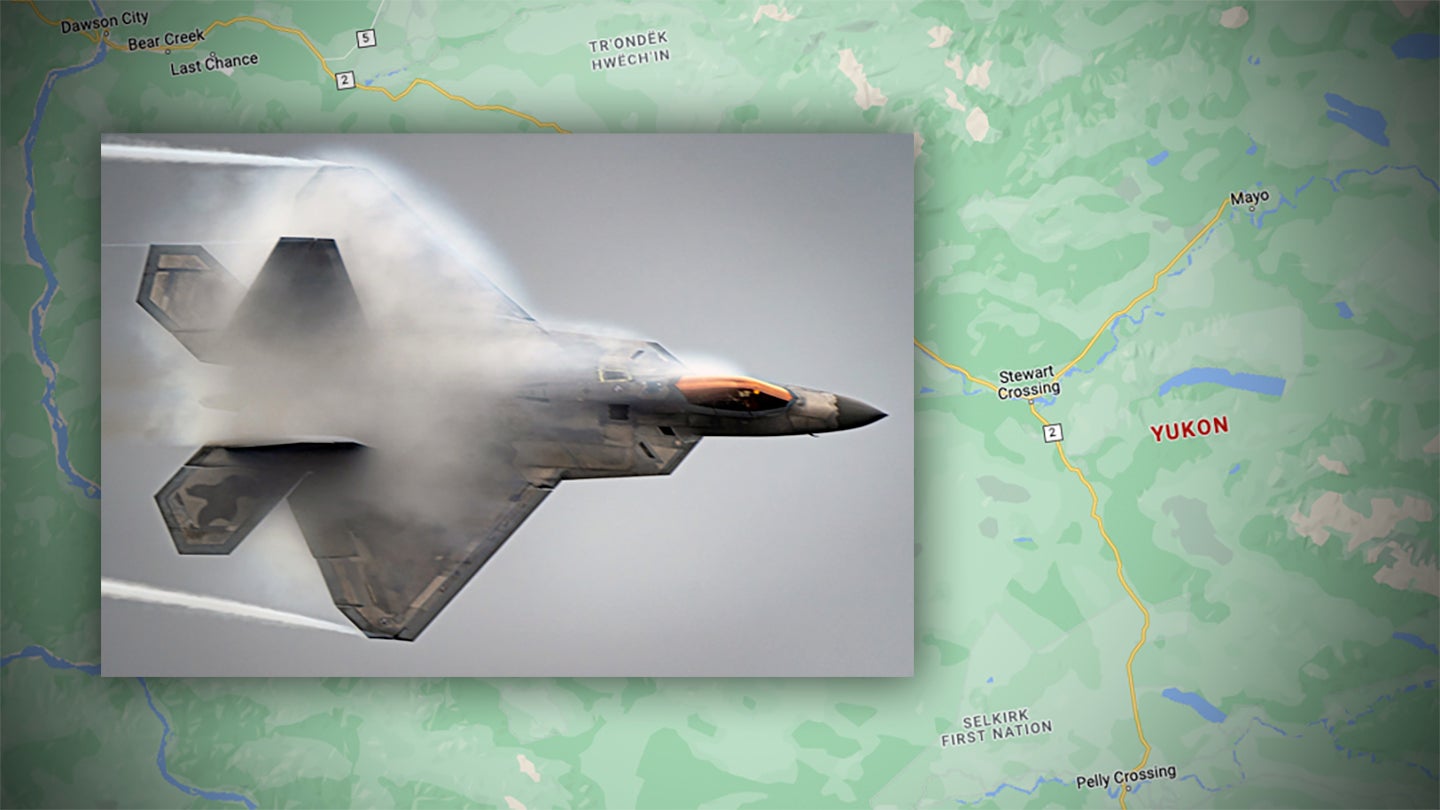F-22 Raptors under the control of NORAD have now shot down two objects in North American airspace within a day, three in the last week.

A U.S. Air Force F-22 Raptor has shot down an object over Canada’s Yukon Territory, per a Tweet from Canadian Prime Minister Justin Trudeau.
The shootdown came shortly after reports emerged that North American Aerospace Defense Command was tracking up to two more objects in northern Canadian airspace. Security sources told Canada’s Global News that NORAD is monitoring the contacts.
Shortly before Trudeau’s tweet, the Federal Aviation Administration posted a Notice to Airmen (NOTAM) with a flight restriction for airspace within 100 nautical miles of the small Yukon town of Mayo. The NOTAM was posted for an “active air defense operation.”
A U.S. F-22, as opposed to a Royal Canadian Air Force CF-18 Hornet, made the intercept likely on account of the Raptor’s greater air-to-air capabilities. Not to mention the fact U.S. interceptors have operated in Canadian airspace as part of NORAD previously.
Saturday’s shootdown comes only a day after an F-22 shot down an unidentified object off Prudhoe Bay, Alaska. NORAD confirmed in a statement to The War Zone that recovery operations continue both off Alaska and off South Carolina.
There are few new details about yesterday’s shootdown, but reports suggest the object remained undetected until well within U.S. airspace. Fox News reported on Saturday that the downed object, reportedly the size of a small car, penetrated U.S. airspace over Alaska’s North Slope without being detected until February 9, per a senior U.S. official.
It remains unknown where the unidentified object downed Friday originated from or what capabilities it may have had. A temporary flight restriction from the Federal Aviation Administration remains in effect in the area until further notice.
The lack of information may be in part because the Pentagon is still trying to figure out exactly what was shot down. In a CNN story posted on Saturday, a source briefed on the intelligence said there are reports that some, but not all, intercepting pilots experienced interference with their aircraft systems during the encounter. Additionally, pilots reported they could see “no identifiable propulsion on the object” to explain it maintaining altitude at 40,000 feet. Of course, lighter than air craft can be made to loo like many things and have no trouble flying at that altitude.
The New York Times reported that the fallen object “broke into pieces” on hitting the frozen sea ice off Prudhoe Bay. A recovery operation is underway on that portion of sea ice now.
According to Sen. Dan Sullivan, R-Alaska, this is not the first time the Pentagon has tracked something unknown as of late over America’s Last Frontier, telling Alaska Public Media that “several other similar objects” have flown over the state in recent weeks. He continued, stating:
“There were things that were seen on radar but weren’t explained… so I don’t know what they were, but I think our military is trying to figure that out as well… But this had similar signatures… I join my fellow delegation members in expecting answers from our military leaders for how unidentified objects have been able to infiltrate our airspace in recent weeks…”
The outlet also said Sullivan claimed that the object entered Alaskan airspace near Nome and moved northeast from there at about 40 knots. In terms of size, it was “Between a 55 gallon drum and a small Volkswagen.”
Sullivan, a member of the Senate Committee on Armed Services, did not reveal his source for the information.
The latest incidents may indicate a policy change by both the U.S. and Canada on airspace intruders and could be a sign of many more like them to come.
Update 6:25 P.M. EST: In a statement, Pentagon Press Secretary Brig. Gen. Pat Ryder confirmed a U.S. Air Force F-22 Raptor downed the unidentified object in Canadian airspace with an AIM-9X Sidewinder on orders from both Prime Minister Trudeau and President Biden.
NORAD detected the unknown object over Alaska late Friday evening, Ryder said in a statement. Two F-22s from Joint Base Elmendorf-Richardson, Alaska, tracked and observed the object with refueling support from the Alaska Air National Guard.
Royal Canadian Air Force CF-18 Hornets and CP-140 Aurora maritime patrol aircraft continued surveillance into Canadian airspace. Coordination on the shootdown included a call between Secretary of Defense Lloyd J. Austin III and Canadian Defense Minister Anita Anand. The Federal Bureau of Investigation and Royal Canadian Mounted Police will work closely on the investigation, Ryder said.
Update 7:00 P.M. EST: President Biden was “continually briefed” on the unidentified object for the 24 hours preceding the shootdown, per a statement from the White House.
“Out of an abundance of caution and at the recommendation of their militaries, President Biden and Prime Minister Trudeau authorized it to be taken down,” the statement reads. “President Biden authorized US fighter aircraft assigned to NORAD to conduct the operation and a US F-22 shot down the object in Canadian territory in close coordination with Canadian authorities.
“The leaders discussed the importance of recovering the object in order to determine more details on its purpose or origin. President Biden and Prime Minister Trudeau commended NORAD’s and U.S. Northern Command’s strong and effective partnership and agreed to continue their close coordination to detect, track, and defend our airspace.”
An F-22 again used the AIM-9X Sidewinder missile for the shootdown. While a whopping $472,000 per AIM-9X may not be a great exchange rate for shooting down “unidentified objects,” The War Zone Editor-in-Chief Tyler Rogoway (@Aviation_Intel) explains how individual shootdowns don’t threaten stockpiles. But a coordinated mass attack by an adversary, however, is another problem entirely.
Update 7:35 P.M. EST: In a press conference, Canadian Defense Minister Anita Anand said the unknown object was a “small, cylindrical object” smaller than the balloon shot down off South Carolina on February 4. The object was reportedly flying at 40,000 feet when it was shot down.
Anand said analysis of the object is ongoing and will be thorough, but would neither say nor speculate on the object’s origins as of Saturday evening. The search is ongoing for where the object hit the ground.
Update 8:05 P.M. EST: The FAA has issued a new temporary flight restriction for airspace up to 36,000 feet around the town of Havre, Montana for “national defense airspace.”
Oregon Air National Guard F-15 Eagles have reportedly scrambled from Portland Air National Guard Base, and a KC-135R from Fairchild Air Force Base in Spokane, Washington, is on station near Great Falls, Montana. It is unclear at this time if these developments are related to the TFR.
Something to keep in mind considering the sun has set over Montana is one perk F-15s have over the F-22: advanced targeting pods with low-light and infrared capabilities.
Update 8:35 P.M. ETS: U.S. House Rep. Matt Rosendale, R-Montana, has tweeted he is in direct contact with U.S. Northern Command about “an object that could interfere with commercial air traffic.” Rosendale said, “the DOD will resume efforts to observe and ground the object in the morning.”
The temporary flight restriction over Havre, Montana, appears to have been lifted as of 8:35 P.M. EST. To be clear, this is not America at war, but this is certainly the Pentagon taking a situation much more seriously.
Update 9:15 P.M. EST: In a statement, NORAD and U.S. Northern Command confirmed the TFR put in place and later rescinded over Havre, Montana was in response to a “radar anomaly” that it sent fighter aircraft to investigate. Those aircraft did not identify any object to correlate to the radar hits, and NORAD is still monitoring the situation.
Update 9:50 P.M. EST: The Wall Street Journal is reporting that the object downed over Canada on Saturday was a small metallic balloon with a tethered payload, according to an official briefed on the matter.
This would correlate with Canadian Chief of Defense Staff Gen. Wayne Eyre’s statement at Saturday evening’s press conference when discussing cooperation between U.S. F-22s and Canadian CF-18s.
“The instructions that were given to the team was whoever had the first, best shot to take out the balloon had the go ahead,” Eyre said.
Additionally, sources have told The Washington Post that some of this week’s detections are indeed the result of adjusted sensors. Radars routinely use gates to filter out objects that it isn’t interested in.
Naturally, air defense radars designed to pick up aircraft and missiles at speed may not be calibrated to detect near-stationary objects. The source said analysts “opened the filters” to better detect the radar returns it would otherwise disregard.
It stands to reason that by opening the filters, radars will not only spot more otherwise undetected objects, but also potentially more false alarms as may have been the case Saturday night over Montana.
The official also spoke in greater detail on the objects themselves, noting that pilots had a long time to observe the Yukon object compared to the one over Prudhoe Bay. Still, there appear to be unique differences between the two.
“All of the objects are similar in certain ways and then dramatically different in certain ways. What we don’t yet understand is what sorts of technology are in there,” the official told The Washington Post. “Really capable technology can be very small and portable. So the size doesn’t tell us a whole lot.”
Update 10:45 P.M. EST: U.S. Sen. Jon Tester, D-Montana, tweeted he is monitoring the reported “radar anomaly” over Havre and is in contact with the DoD. Tester was previously quoted in The Washington Post criticizing the Pentagon for its handling of recent incidents.
“I don’t want a damn balloon going over the United States when we could have taken it down over the Aleutian Islands,” Tester said.
When asked why there were seemingly more balloon downings and related incidents recently, a U.S. official told Politico: “We are being more vigilant now.”
We will continue to update this story as more information becomes available.

